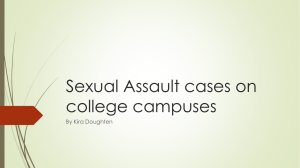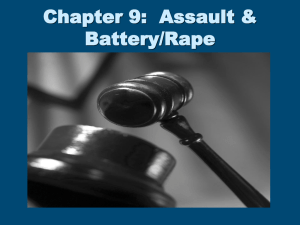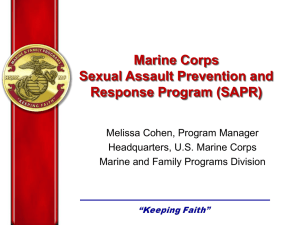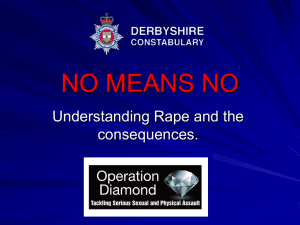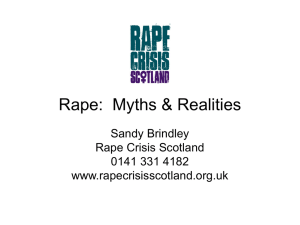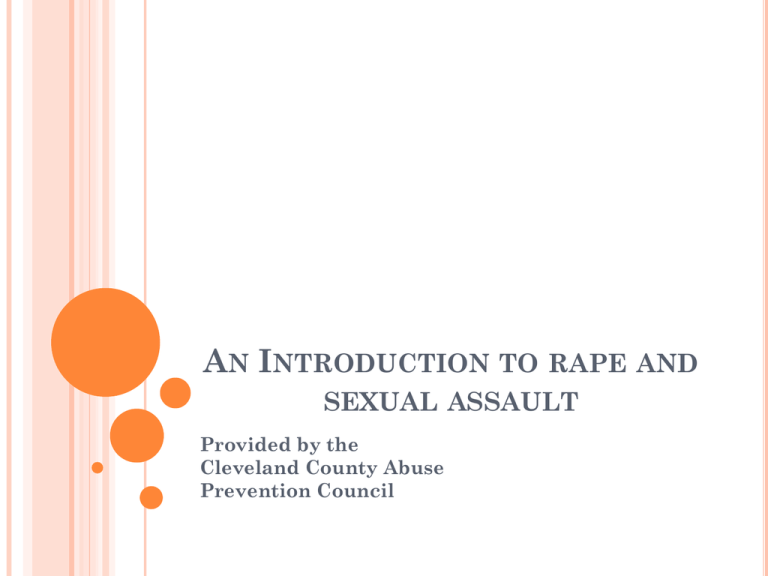
AN INTRODUCTION TO RAPE AND
SEXUAL ASSAULT
Provided by the
Cleveland County Abuse
Prevention Council
RAPE AND SEXUAL ASSAULT
WHAT IS IT?
Common Definitions:
The unlawful use of physical force or duress to
have sexual intercourse
Any act of sexual intercourse that is forced
upon a person against their will
NORTH CAROLINA LAWS/DEFINITIONS
Rape Vaginal intercourse with a person by force and
against the person’s will (without consent)
Statutory Rape Vaginal intercourse or a sexual act with a person
fifteen years of age or younger
Marital Rape Same definition as rape, but occurs when victim and
offender are legally married
Sexual Offense A sexual act, other than vaginal intercourse, with a
person by force and against a person’s will.
These
are all considered felonies in NC
In NC, a person cannot legally give consent for sex
until the age of 16.
A sexual act is legally defined as oral sex, anal sex, or
the insertion of hands, fingers, other body parts or
inanimate objects into another’s anal or genital
opening.
The use of a weapon or perceived threat of a
weapon determines a first or second-degree offense.
If the offender has a weapon, it is considered to be
first degree. Both are still felonies.
The offender is said to have used force when the
victim feels he/she has no control over the situation.
This can include verbal or physical threats.
The FBI now defines rape as any kind of penetration
of another person, regardless of gender, without the
victim's consent. It also includes a broad range of
rapes involving both males and females in which
attackers use objects to penetrate their victims.
MYTHS & FACTS
MYTH:
Rape is caused by the victim. If a woman flirts or wears sexy
clothing, she is “asking for it”.
FACT:
Rape is a violation of body, mind, and spirit. It takes away a
person’s control over her/his own body choices. Both men and
women may want to look attractive, but no one “asks for” or
enjoys a violent physical attack, which puts them at risk of
injury, disease, pregnancy, or death.
Rape is not an act of sexual passion; it is a violent
crime in which sex is the weapon.
MYTH:
Rape is an impulsive, uncontrollable act of sexual
gratification. Most rapes are spontaneous; such as when
a sexually frustrated man sees an attractive woman and
just cannot control himself.
FACTS:
Rape is a premeditated act of violence, not a spontaneous
act of passion
- 71% of rapes are planned in advance.
- 60% of convicted rapists were married or had
regular sex partners at the time of the rape
- Men CAN control their sexual impulses
MYTH:
No woman can be raped against her will. Any woman could
prevent a rape if she really wanted to.
FACTS:
Women are often physically weaker than their attackers and many
times do not know how to effectively defend themselves.
Additionally, many women are not willing to hurt their attacker,
especially if it is someone they know.
MYTH:
Rape is a woman’s problem
FACTS:
Both men and women are victimized by rape and sexual
assault. Most people know someone who has been raped or
assaulted and these victims are the wives, mothers, sisters,
and daughters of men.
MYTH:
Most rapes occur when people are out alone at night. If people
stay home, they will be safe.
FACT:
1 in 4 sexual assaults take place in the victim’s home, making it
the most common place for this crime to occur.
MYTH:
Rapists are strangers.
FACT:
In North Carolina more than 52% of the forcible rapes reported
were acquaintance rapes. Unfortunately, we know that assaults
by known assailants often go unreported, so this statistic does
not reflect the actual numbers of acquaintance rapes taking
place.
MYTH: If the attacker, the victim, or both
are drunk or high, the attacker cannot be
charged with rape.
FACTS: Forcing sex on someone too drunk or
high to give consent is considered second-degree
rape in North Carolina. It carries a sentence of
up to 40 years. Rape is a crime. People who
commit crimes under the influence are not
exempt from responsibility. Additionally,
purposefully drugging a victim prior to a rape is
now punishable as a felony in North Carolina.
WHAT TO SAY TO A VICTIM?
It is not your fault (the victim is not the one to blame)
You are not responsible for the rape (the rapist is)
I believe you
Have you received medical attention and/or information about
emergency contraception?
I care about you, what can I do to help you through this?
I support your right to feel whatever you are feeling
I’m here to listen, even if you’re not ready to share all the details
WHAT NOT TO SAY…
Be thankful, you’re lucky to be alive, it could have been worse.
What did you do to encourage him?
How could you let this happen?
You must forgive and forget.
Just quit thinking about it; don't let it ruin your life.
You should have... known better, fought harder, yelled louder, etc.
Why were you… drinking, dressed that way, out at that time, in that
place, with those people, etc.
ENCOURAGE THE VICTIM TO…..
Get to a safe place as soon as possible.
Tell someone about the assault (friend, police, crisis line, etc).
Keeping the secret will only protect their attacker and may be
emotionally harmful to the victim.
Get medical attention from the ER, Health Department, or their
personal physician as soon as possible to treat injuries and test
for STIs.
Have an evidence collection kit performed within 72 hours of
the assault to collect all available evidence. Most evidence is
gone after 48-72 hours.
Report the assault to the police immediately so they can begin
looking for the suspect.
Call a friend, family member, or rape crisis center for support
during medical and legal procedures.
Seek counseling to cope with their feelings after the assault.
Ask an advocate at a rape crisis center for options regarding
safety, prosecution, financial compensation, medical
treatment, counseling, etc.
DON’T ENCOURAGE THE VICTIM TO…
Bathe, douche, urinate, change clothes, eat, drink, or apply
medication to yourself prior to seeking medical treatment.
These things destroy evidence that your attacker may have left
behind.
Disturb or clean up anything in the area where the assault
occurred. There may be evidence that can be collected.
Skip seeking medical treatment because there are no visible
injuries. It is important to be tested for STIs and pregnancy as
well as to be treated for possible internal injuries.
Act like the assault did not occur. It is important for victims to
recognize that any non-consensual violation of their body is not
okay and they have a right to pursue action against their
attacker.
LEGAL COURSES OF ACTION FOR VICTIMS OF RAPE
Victims of rape/sexual assaults are NOT LEGALLY
OBLIGATED to press charges against their attacker(s).
The State may choose to press charges.
Victims have the option to report their assault to the
law enforcement or not.
A victim may choose to do an anonymous report. The
rape kit and all other evidence is sent to a central
holding facility in Raleigh. It is held there until the
victim decides they want to prosecute. The victim can
make this decision at any time even years after the
crime.
IF A VICTIM DOES NOT REPORT
Victims
may choose not to report the incident,
although in some instances the police may be
called by medical personnel when the victim
goes to the ER for treatment.
No Report =
No Investigation
No Prosecution
No record of the assault other than the anonymous
evidence in the central storage facility if the victim
choose to report anonymously
VICTIMS WHO FILE A REPORT
Allows law enforcement the opportunity to begin
investigating the incident and take steps to catch assailant
Protects the victim and their community
Even if the victim is unsure about prosecuting, the report
enables the police to investigate while the evidence is fresh.
This evidence will be helpful if the victim decides to
prosecute or not.
And if the victim does not choose to prosecute, the evidence
collected could be helpful if the same assailant assaulted
another person
While each victim retains their right to choose
not to report their assault, at APC we generally
encourage each victim to report his or her
assault to the police.
ONCE REPORT HAS BEEN FILED
The Victim has three options:
1.
Criminal Charges against the rapist
2.
Civil Charges against the rapist
3.
Charges against a Third Party
Criminal charges- Rapes are crimes against the State as
well as the victim. Once a crime is reported, the state pays
to have it investigated and prosecuted. Victims are seen
as witnesses and do not need to obtain their own attorney.
The Victim’s attorney will be the DA (District Attorney).
The DA looks at the evidence and determine if there is
enough evidence to convict.
Civil Charges- Claiming damages against the rapist.
Requires the same evidence as criminal charges, but the
victim has to hire their own attorney. The goal is financial
compensation for the victim due to mental and/or physical
suffering as a result of the assault.
Charges Against 3rd Party- Brining a Civil case against
people who could be held responsible (parents allow teens
to have party, no supervision, and someone is
raped/underage drinking resulting in a death). Some cases
have found institutions, landlords, employers, and
transportation systems liable for assaults. When
dangerous conditions were reported, and people failed to
take action. Attorney must be hired for this type of action.




